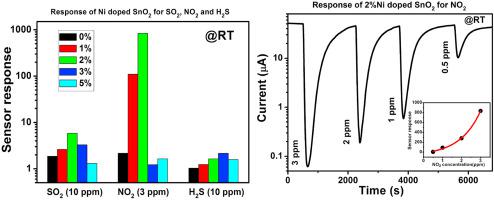当前位置:
X-MOL 学术
›
J. Alloys Compd.
›
论文详情
Our official English website, www.x-mol.net, welcomes your
feedback! (Note: you will need to create a separate account there.)
Enhanced NO2 and SO2 sensor response under ambient conditions by polyol synthesized Ni doped SnO2 nanoparticles
Journal of Alloys and Compounds ( IF 5.8 ) Pub Date : 2021-02-01 , DOI: 10.1016/j.jallcom.2020.157276 Soumitra Das , K.G. Girija , A.K. Debnath , R.K. Vatsa
Journal of Alloys and Compounds ( IF 5.8 ) Pub Date : 2021-02-01 , DOI: 10.1016/j.jallcom.2020.157276 Soumitra Das , K.G. Girija , A.K. Debnath , R.K. Vatsa

|
Abstract Undoped and Ni doped SnO2 nanoparticles were synthesized by low temperature polyol route and systematically investigated for gas sensing applications. XRD, SEM and TEM studies confirmed the tetragonal rutile phase and the nanocrystalline nature of SnO2 particles. Doping of Ni and the formation of various defects/oxygen vacancies in SnO2 were supported by XPS, PL and UV–Vis spectroscopic measurements. For gas sensing studies, sensors were fabricated by drop casting of the nanoparticles on gold inter-digitated electrodes and tested at room temperature (∼25°C). It was found that 2 at% Ni doping has improved the sensor response towards SO2 (∼6 for 10 ppm) and NO2 (∼850 for 3 ppm) significantly. Excellent sensor response and selectivity of Ni doped SnO2 for NO2 could be attributed to the formation of preferred type oxygen vacancies, favourble adsorption sites and the surface hydroxyl groups due to optimum Ni doping. Since the Ni doped SnO2 sensor exhibited opposite response signal towards SO2 (decrease in resistance) and NO2 (increase in resistance), the same sensor can be used for the selective, sensitive and reversible detection of both SO2 and NO2, especially operating at room temperature.
中文翻译:

通过多元醇合成的 Ni 掺杂 SnO2 纳米粒子在环境条件下增强 NO2 和 SO2 传感器响应
摘要 通过低温多元醇途径合成了未掺杂和镍掺杂的 SnO2 纳米粒子,并系统地研究了其气敏应用。XRD、SEM 和 TEM 研究证实了四方金红石相和 SnO2 颗粒的纳米晶体性质。XPS、PL 和紫外-可见光谱测量支持 Ni 的掺杂和 SnO2 中各种缺陷/氧空位的形成。对于气体传感研究,传感器是通过将纳米颗粒滴铸在金叉指电极上来制造的,并在室温(~25°C)下进行测试。发现 2 at% Ni 掺杂显着改善了传感器对 SO2(10 ppm 约 6)和 NO2(3 ppm 约 850)的响应。Ni 掺杂的 SnO2 对 NO2 的出色传感器响应和选择性可归因于优选类型氧空位的形成,由于最佳的 Ni 掺杂,有利的吸附位点和表面羟基。由于 Ni 掺杂的 SnO2 传感器对 SO2(电阻降低)和 NO2(电阻增加)表现出相反的响应信号,因此同一传感器可用于 SO2 和 NO2 的选择性、灵敏和可逆检测,尤其是在室温下工作.
更新日期:2021-02-01
中文翻译:

通过多元醇合成的 Ni 掺杂 SnO2 纳米粒子在环境条件下增强 NO2 和 SO2 传感器响应
摘要 通过低温多元醇途径合成了未掺杂和镍掺杂的 SnO2 纳米粒子,并系统地研究了其气敏应用。XRD、SEM 和 TEM 研究证实了四方金红石相和 SnO2 颗粒的纳米晶体性质。XPS、PL 和紫外-可见光谱测量支持 Ni 的掺杂和 SnO2 中各种缺陷/氧空位的形成。对于气体传感研究,传感器是通过将纳米颗粒滴铸在金叉指电极上来制造的,并在室温(~25°C)下进行测试。发现 2 at% Ni 掺杂显着改善了传感器对 SO2(10 ppm 约 6)和 NO2(3 ppm 约 850)的响应。Ni 掺杂的 SnO2 对 NO2 的出色传感器响应和选择性可归因于优选类型氧空位的形成,由于最佳的 Ni 掺杂,有利的吸附位点和表面羟基。由于 Ni 掺杂的 SnO2 传感器对 SO2(电阻降低)和 NO2(电阻增加)表现出相反的响应信号,因此同一传感器可用于 SO2 和 NO2 的选择性、灵敏和可逆检测,尤其是在室温下工作.











































 京公网安备 11010802027423号
京公网安备 11010802027423号